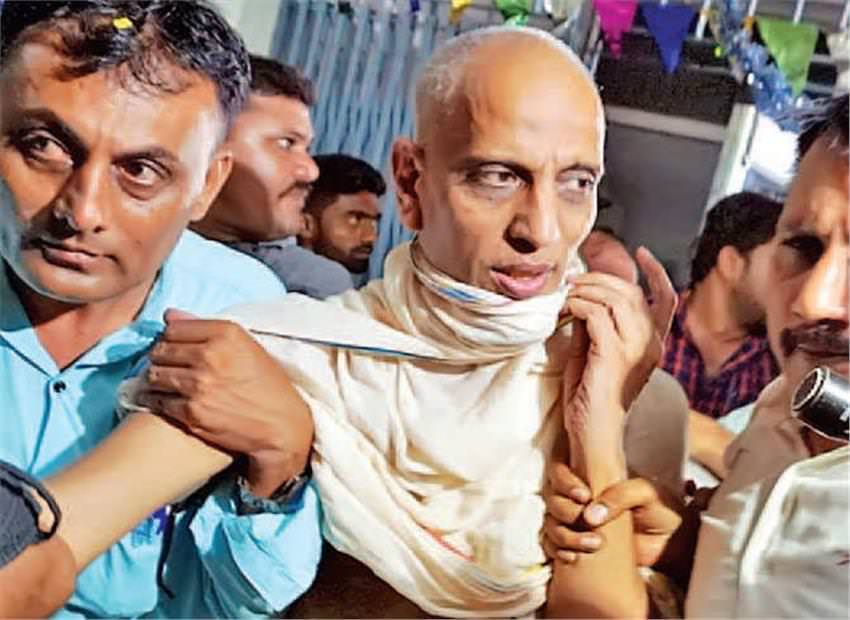Posted by Aishwarya Bhuta
On October 1, 2017, a young nineteen year old girl went to Nanpura Timliyawad Jain Dharmshala, Surat to seek the blessings of Acharya Shanti Sagar Maharaj, a Digambar Jain monk. She was accompanied by her parents and elder brother. Apparently, the monk asked the family to wait till late evening.
Around 8.30 p.m., he asked the girl to stop by the night for mantra jaap (a prayer ritual). Under this pretext of prayer, the monk raped her. When she told her parents about it, they could not believe it. She filed an FIR accusing the monk. Upon medical examination, it was confirmed that she was raped. Subsequently, he was arrested on October 14.
His followers had a lot to offer in his defence, more than what he had. While some of them said that this was clearly an attempt to defame the muni (saint), others said that he wasn’t a monk at all. As for the culprit himself, he initially maintained that it was a conspiracy against him and the girl had been paid by someone to do it.
However, when the police shared the girl’s allegations with him, he changed his statement. He confessed that he had engaged in sexual intercourse with her, albeit consensually, and it was his first time ever. He had been acquainted with her since the past five-six months. When the doctor asked him why he had done it if he was a monk, he had no answer.
As for the culprit himself, he initially maintained that it was a conspiracy against him and the girl had been paid by someone to do it.
Digging deeper into his past – who is Shanti Sagar? According to reports in Hindi newspapers such as Dainik Bhaskar and Amar Ujala, the accused spent his early years in Guna, Madhya Pradesh with his uncle. His family stayed in Kota, Rajasthan. Before attaining monkhood, his name was Giriraj Sharma. He used to be an energetic young boy who enjoyed playing cricket.
At the age of 22, he came across Digambar Jain monks in Mandsaur, MP and suddenly decided to take diksha (initiation) and become a monk. Here, it must be noted that he was not born in a Jain family. There are many Jains who choose to renounce the world at an early age, but here it is their early socialisation that is to blame. Children whose families spend a lot of time in the service of monks are more easily attracted towards the idea of diksha. In the Jain fold, there have been instances of kids as young as twelve years, who have attained diksha ‘voluntarily’.
Being a Digambar Jain monk demands austerity. Right from giving up clothes to eating only once a day, fasting several times, travelling only by foot, and staying confined to one place for four months in a year, to name a few. What might have happened in Shanti Sagar’s case? Was it really his ‘first time’ in more than two decades of monkhood? Had he been continuing such activities in the night behind closed doors with many other girls and women?
Also Read: Where Does The Identity Of Female Ascetics Lie In Hinduism?
Jains have always glorified renunciation; that is their only way to moksha or liberation. Quite obviously, women are considered inferior and incapable of moksha, because even if they assume diksha and become maataji (nuns), they cannot give up clothes like men do. Again, the reason for women not being allowed to give up clothes is that it will sexually arouse the men, impeding their pursuit of liberation. Not only that, naked women would feel ashamed of being naked, which will not let them attain moksha either.
Another reason is that the Digambaras believe that women are inherently hinsak or violent. This stems partly from a belief that menstrual blood kills micro-organisms living in the female body, rendering the female body less non-violent than that of a male. The final argument is related to attachment.
Reinforcing gender stereotypes, Digambaras assert that since women are caring and nurture children and other dependants, they find it much more difficult to break free from these worldly attachments, and unless they do this, they cannot achieve liberation. An unstable mind and less grasping power are considered to be characteristics that make it impossible for women to attain moksha.
the reason for women not being allowed to give up clothes is that it will sexually arouse the men, impeding their pursuit of liberation.
Such orthodox and patriarchal notions are attached with the idea of moksha. Yes, the rapist is wrong; but over credulous followers are equally guilty. Who gifted the monk a mobile phone that he used to send obscene Whatsapp messages to the girl? Who ‘donates’ thousands and lakhs of rupees when monks and nuns ask for it? Who pays thousands for seeking their blessings? It is the Jain layperson or shravak (disciple)?
It is the case with every self-styled godman; their shops are never empty because there are more than enough bhakts (devotees) for them to carry on their business. These monks are thriving because it is the bhakts who are making it possible for them in every way – be it by giving money or service. Such is the charismatic authority of the maharaj (leader) that the bhakts enagage in hero-worship as an easy solution for all their problems. The true dharma (inherent nature) of a Jain – good karma, kindness, compassion, non-violence lies forgotten.
If they have renounced the world, it is their choice. It does not make them god, they are as human as anybody else. As followers, you may worship someone as your guru if she/he shows you the right path – but remember that your paths are separate because she/he has renounced worldly life and pleasures.
Lead your life your way and let them lead it the way they should be leading it – with pure austerity. And the moment they don’t do it, you should recognise that they are not true renouncers. Renounce him before he commits a crime; renounce his hypocrisy. Renounce your unquestioning faiths and open your eyes to the truth around you – which need not be naked in order to achieve liberation!
Also Read: Ram Rahim Verdict And The Structural Inequalities We Conveniently Ignore
Aishwarya Bhuta is a graduate in the Social Sciences. She belongs to the Digambar Jain community. Her writings revolve around social themes, mainly women’s issues. She believes in the power of the pen as a strong means of expression and rebellion against social evils. She wants to usher social change through her works.
Featured Image Credit: Daily Bhaskar





Please stop making comments on a religion without even knowing it.
Kudos!! Keep Writing on such topics which people can’t even think of discussing in public…Faith is good but we should also have courage to question..!!
I am a staunch Jain and one of my personal responsibilities is to seek the truth. I am glad more people are coming out and identifying the false monks. I personally believe that men and women are all equal – just as Mallinath (a woman) was able to achieve Moksha, similarly any/all women can achieve Moksha. Being a monk is not the only way to Moksha – the key is to have a completely clean heart. Hope more Jains realize it and stop believing in false monks. Lately, it has become a joke and a fad to become a Jain monk along with the mega celebrations that happen. Just like Mahavir became a monk without much fanfare, same way, if anyone wants to become a monk, they should do it without fanfare and they should use their money to do some good rather than celebrate with a party. Glad Aishwarya Bhuta wrote this piece but not all Jains believe that women are inferior.
Why only male nudity is allowed in religion, why this is only justified for men, if female nudity is provocative then same is applied for men also.